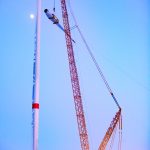Safety training is critical in the construction industry because it’s a high-risk workplace with hazardous work. Dangerous situations are part of the everyday working environment. The constant challenge for construction companies is to create and deliver effective safety training.
“The traditional way of handling safety training tends to be boring and doesn’t take into account the natural learning style of construction workers,” said Abby Ferri, vice president, national construction practice, Hays Companies, a Minneapolis, Minnesota-based risk management, insurance and employee benefits adviser. “It is more effective to provide hands-on training, and if this can’t be done in the immediate workplace, the training should be done in some sort of a simulation of the workplace or at least do meaningful activities that bring the workplace into the classroom.”
Ferri, who has been involved in construction safety for more than 16 years, has found that, rather than building a PowerPoint presentation for a particular topic, it is more effective to determine the learning objectives for the particular training, identify learning activities that can be facilitated with the students (workers), and then guide them through the training.
“It is important that the training be interactive, because this helps to keep everyone involved,” she said.
The trainer needs to digest what is being shared, understand the group that is taking the training, and, if necessary, adjust the learning activities to make it applicable, she said.
Ferri is conducting an “in the field” Safety Tech Trek at ICUEE, October 1-3, 2019, in Louisville, Kentucky.
These are some of the top construction safety technologies to keep an eye on:
• Wearables and Embedded Technology: This technology involves attaching various types of mobile electronics and embedded sensors to the body and personal protective equipment for a wide range of purposes.
• IoT (Internet of Things): By combining the real-time data generated by wearables, embedded technology, and GPS tracking with the IoT, Big Data can be used to monitor and measure a wide variety of safety performance metrics within the construction industry.
Enterprise Solutions: These are designed to integrate multiple facets of jobsite safety through the interchange of information from “connected” workers and a “connected” jobsite.
• Collision Avoidance Systems: Technologies will continue to evolve to further improve blind-spot coverage, proximity detection alerts, detecting the presence of workers, collision avoidance systems, and systems that monitor equipment operators and keep a record of their performance.
• Microlearning: This involves breaking down information into compact, focused learning segments — usually three to five minutes long — that are designed to meet a specific learning outcome. The training, which can be viewed on a smartphone or tablet in the field, is easier to process, and knowledge retention is increased.
• Apps: Mobile applications are making it easier to get safety training to workers, plus they help safety managers be more productive.
More info www.aem.org








































